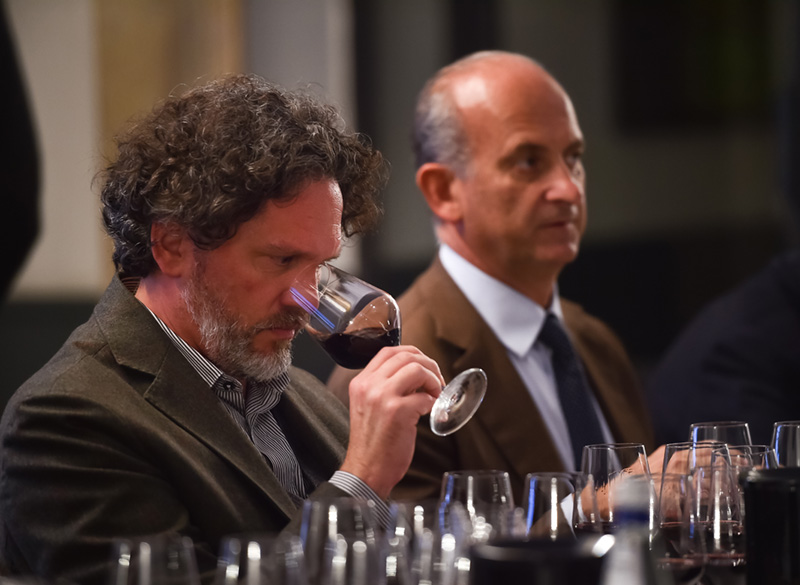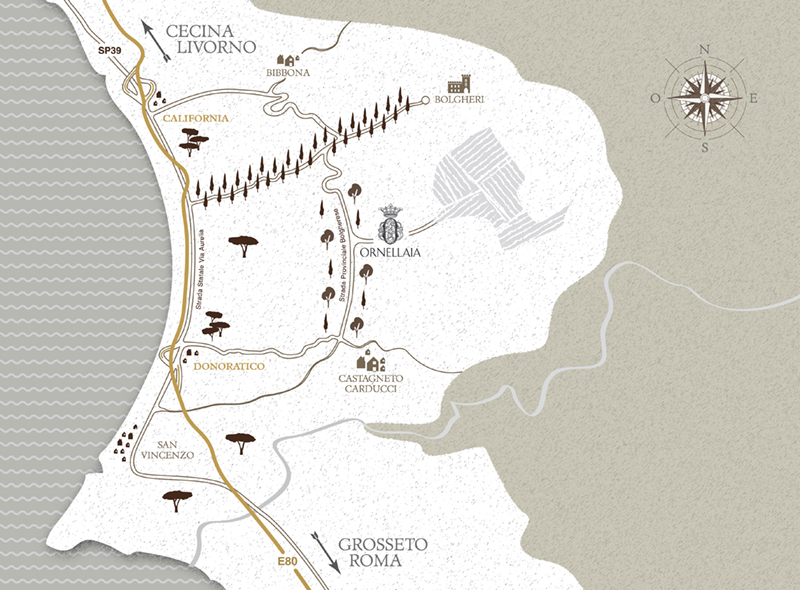Ornellaia Estate has long been one of the Bolgheri region’s best. Ornellaia Rosso, the estate's top of the line, is a blend of Cabernet Sauvignon, Cabernet Franc, Merlot, and Petit Verdot. It rivals not just any other “Super Tuscan,” but the best wines from any region focused on those varieties.
While in Rome recently on a trip with Gambero Rosso, I tasted through eight vintages of Ornellaia Rosso. Sitting across the table from me were Axel Heinz, estate director and head winemaker for Ornellaia, and Lamberto Frescobaldi, president of Marchesi Frescobaldi, which owns Ornellaia and numerous other Italian estates. The tasting was part of an entire evening with Frescobaldi, which Gambero Rosso named “Winery of the Year” for 2020.
Axel selected the vintages and led the tasting. My detailed notes on the tasting will follow in my next article. But, for today, lets take a closer look at Ornellaia overall.
 Axel Heinz and Lamberto Frescobaldi, October 2019. Image courtesy of Gambero Rosso.
Axel Heinz and Lamberto Frescobaldi, October 2019. Image courtesy of Gambero Rosso.
Key Milestones in Ornellaia History
1981 — The Marchese Lodovico Antinori establishes the estate. Planting begins the following year.
1983 — The Bolgheri DOC is established for white and rosato wines only.
1985 — The first vintage from which Ornellaia wine is made. The wine is released in 1988.
1991 — Michel Rolland signs on as consulting enologist, a role he still has.
1994 — Bolgheri DOC expands its scope to red wines
1999 — Robert Mondavi assumes partial ownership
2002 — Mondavi assumed full ownership, then immediately transfers 50% to Frescobaldi.
2005 — Mondavi Corporation is sold. Frescobaldi purchases the remainder of Ornellaia. Axel Heinz joins as winemaker.
About Ornellaia Estate Vineyards
Ornellaia Estate consists of three vineyards located near each other in the low hills of Bolgheri. They are named Ornellaia, Ferruggini, and Bellaria. They face the Ligurian Sea, just four miles to the west. The site is very sunny, but cooled by maritime breezes. [Ornellaia Estate is often just called Ornellaia, as is its top-of-the-line wine, Ornellaia Bolgheri DOC Superiore Rosso. This article uses the formal names to avoid confusion.]
Collectively, the estate includes three basic soil types: maritime sedimentary, alluvial, and volcanic. That allows for several different varieties to thrive and creates diversity within single varieties, driving complexity.
Of the 283 planted acres, 267 are devoted to red varieties. Merlot constitutes 40%, Cabernet Sauvignon 36%, Cabernet Franc 16%, Petite Verdot 7%, and “other” 1%. There are more than 60 harvest lots, based on location, soil, and variety.
Each red-variety lot is fermented separately and then aged individually for 12 months in French oak barrels. Only after that year, when the wines are more clearly showing their character, is the base wine for each cuvée determined and blending begun.
In most years, Ornellaia Estate makes seven wines, plus grappa and olive oil. There are the wines:
- Ornellaia Bolgheri DOC Superiore Rosso — The top-of-the-line, a blend of Merlot, Cabernet Sauvignon, Cabernet Franc, and Petit Verdot
- Ornellaia Toscana IGT Bianco —A barrel-fermented white blend dominated by Sauvignon Blanc. Sometimes it's 100% varietal
- Le Serre Nuove dell' Ornellaia Bolgheri DOC Rosso — The "second" red wine, made with the same varieties as Ornellaia and in the same way, but intended to be more accessible upon release
- Le Volte dell' Ornellaia Toscana IGT Rosso — A red blend with varieties fermented separately in stainless steel, then aged in concrete tanks and used oak barriques; ready-to-drink upon release
- Poggio alle Gazze dell' Ornellaia Toscana IGT Biano — A Sauvignon Blanc-based white blend with different components seeing oak, stainless steel, and concrete
- Variazioni in Rosso dell' Ornellaia Toscana IGT — A red blend which highlights a particular variety that changes based on the vintage, available only at the estate
- Ornus dell' Ornellaia Toscana IGT Bianco — A sweet white wine made from late-harvest Petit Manseng
For years, Ornellaia was also known for a wine they called Masseto. It’s 100% Merlot and one of the highest-scoring wines of that variety in the world. A few years ago, Ornellaia created a separate identity for Masseto, so it’s no longer tied to the Ornellaia brand. In 2018, Masseto completed its own winery building. It’s still within the Frescobaldi family though, and Axel Heinz still has primary responsibility for its wine. The acreage numbers above don’t include Masseto.

About DOC Bolgheri
DOC Bolgheri regulations broadened in 1994 to include red (rosso) wines. Prior to 1994, such wines could only be labeled Vino da Tavola, Italian table wine. [The IGT Toscana appellation wasn’t established until 1995.] There are currently 2,928 acres in production for DOC Bolgheri wines (red, white, or rosé).
DOC Bolgheri Rosso wines cannot be released before September 1st of the year after harvest. There is also a DOC Bolgheri Rosso Superiore. Those must be held until at least the third January after harvest. They must also age at least 12 months in 225 liter oak barrels. The maximum yield for DOC Bolgheri Rosso is 3.64 tons/acre, 3.24 for DOC Bolgheri Rosso Superiore.
The red wines of both designations may include the following:
- 0-100% Cabernet Sauvignon
- 0-100% Cabernet Franc
- 0-100% Merlot
- 0-30% Sangiovese
- 0-30% Syrah
- 0-30% other, complementary red grapes, such as Petit Verdot
Note that, despite being allowed up to 50%, there is very little Sangiovese planted in the DOC. Here’s the distribution of primary grape varieties as a percentage of total DOC acres.
- Cabernet Sauvignon 42.34%
- Merlot 25.07%
- Cabernet Franc 9.41%
- Petit Verdot 6.04%
- Syrah 6.93%
- Sangiovese 1.82%
- Vermentino 6.70%
- Viognier 0.52%
- Sauvignon Blanc 0.33%
Why Not Sangiovese?
Climate is the reason DOC Bolgheri has so little Sangiovese and so many Bordeaux varieties. The moderating influence of the nearby sea makes the climate too cool for fully ripening Sangiovese, but it’s just right for Bordeaux varieties. Prior to the latter becoming popular there in the 1980s, all but a tiny fraction of the wine made in the Bolgheri area were white or rosé.
Conclusion
Be sure to read the next article. The wines were tremendous and very different from each other, reflecting their respective vintages.
In the meantime, check out JJ Buckley's Bolgheri wines.
JJ Buckley guest blogger Fred Swan is a San Francisco-based wine writer, educator, and authority on California wines and wineries. His writing appears in The Tasting Panel, SOMM Journal, GuildSomm.com, Daily.SevenFifty.com, PlanetGrape.com, and his own site, FredSwan.Wine (formerly NorCalWine). He teaches at the San Francisco Wine School. He's founder of Wine Writers' Educational Tours, an annual, educational conference for professional wine writers. He also leads private wine tours and conducts tastings and and seminars. Fred’s certifications include WSET Diploma, Certified Sommelier, California Wine Appellation Specialist, Certified Specialist of Wine, French Wine Scholar, Italian Wine Professional, Napa Valley Wine Educator, Northwest Wine Appellation Specialist, and Level 3 WSET Educator. He's twice been awarded a fellowship by the Symposium for Professional Wine Writers.
Images courtesy of Ornellaia